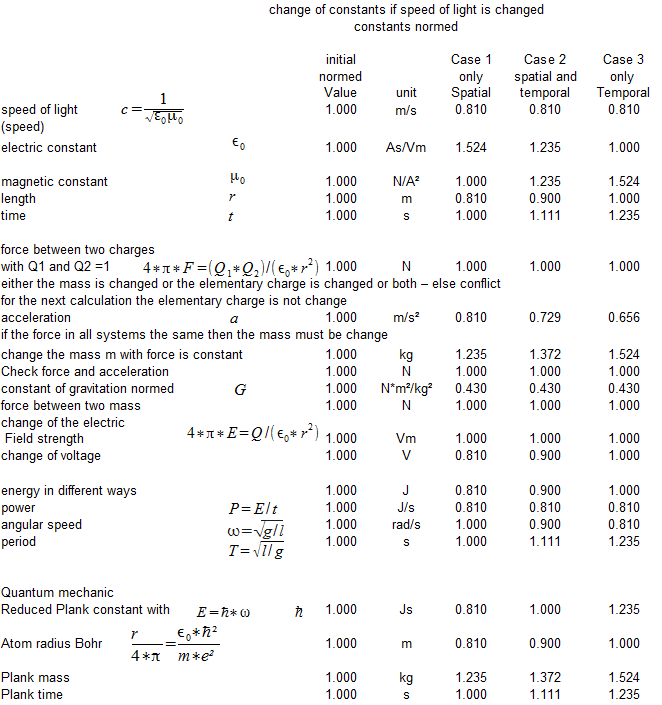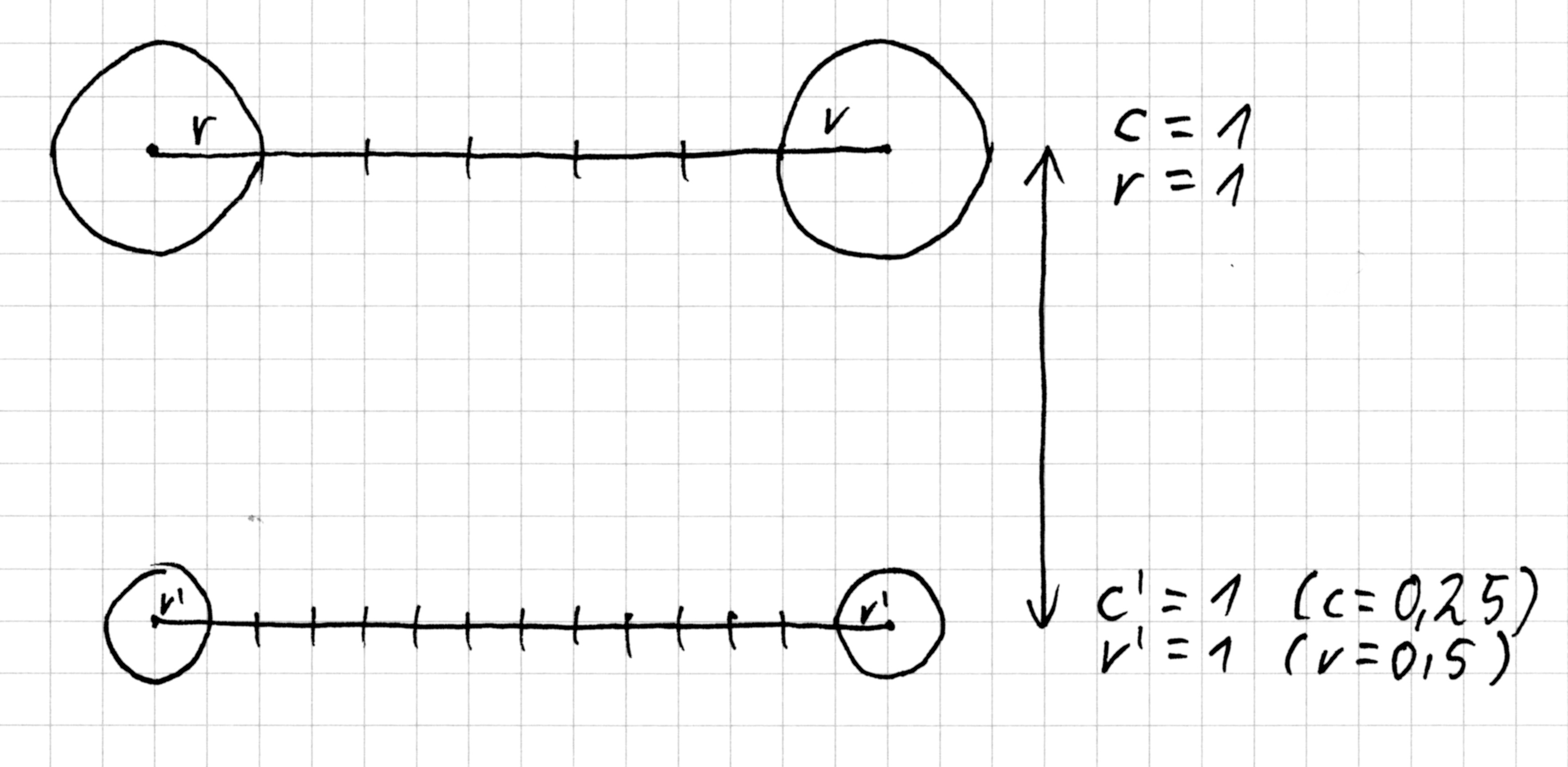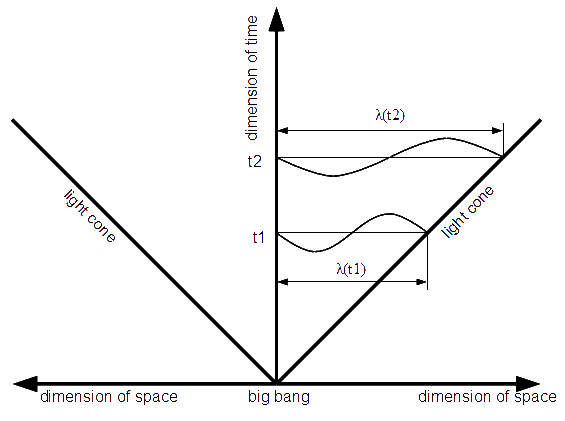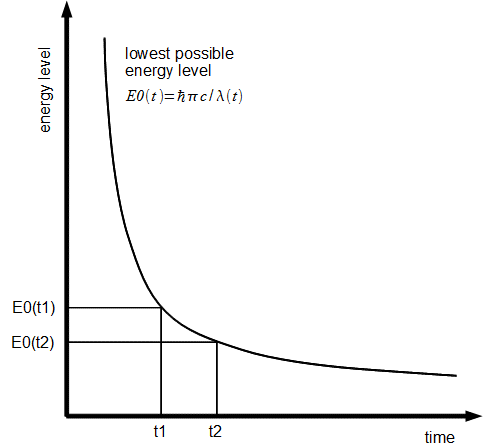The Expansion of the Universe into four Dimensions -
Artikel in Deutsch : Die Expansion des Universums in 4 Dimensionen - die Richtung der Zeit
article
in PDF- version G.Rowski 2011/01/07 last update 2018/01/05
List
of Reference
additional
The end of
the time or why black holes can not come into existence in this
universe 2011.06.01
feedback
- mailto G.Rowski
1. Preliminary considerations - philosophy of knowledge[1]
There is an objective reality, i.e. reality exists
independently from consciousness.
Our consciousness reflects reality correctly, i.e. the world is visible.
There is no movement without matter and no matter without movement.
Movement is matter’s way of existence.
2. Why do natural constants slot together?
Why are our natural constants compatible? The changing of one
single natural constant would mean that our universe couldn’t
exist in its actual form or a universe could not come into being.
Assuming that there has been a big bang and our universe has come into
being, we can postulate that it had been a whole
before, disaggregated into its components (here: the natural constants)
which make up our universe, by the big bang.
If, - in whatever way, a whole disaggregates into its
components, the parts thereof show a joint characteristic:
compatibility. This is why it makes little sense in this
context to contemplate a single component or to make any statements on
what would happen if things were different.
go top
2.1. Speed of light - a theory of relation
Acceptance: The speed
of light is the maximum speed with which
all known interactions can take place, the constant that
determines everything in the universe.
If we were to change the speed of light and we look at how the
other constants must change in order to keep
the same relation to the speed of light.Since the speed of light is
a relation between space and time, it can be changed in several
ways – only the spatial component, both components or only
the temporal component.
Three cases
correspondingly are compared:
Case 1: only the spatial component changes – less distance in
the same time
Case 2: the spatial and temporal component changes – less
distance in more time
(in this consideration,spatial and temporal components change in the
same relationship)
Case 3: only the temporal component changes – same distance
in more time
The comparison for better clarity will be with normed
constants. All constants are put for the initial
situation with unchanged lightspeed 1. The change of the speed of
light c shall amount to 81% of the initial
situation – it
changes from 1 m/s of exit system to 0. 81 m/s (normed).
This results in a new distance r and a new time t.
Case 1 : r = 0. 810 m ; t = 1. 000 s
Case 2 : r = 0. 900 m ; t = 1. 111 s
Case 3 : r = 1. 000 m ; t = 1. 235 s
all results are rounded to 3 places after the comma
In all 3 Cases we have only considered which of the physical
constants depends of the spatial and witch depends of the temporal
component (and in which way). We start with the electric constant
ε0 and the magnetic
constant μ0
The equation  is remodel to
is remodel to  arise, considering that
ε0 only
depends of spatial and μ0
only depends of
the temporal components.
arise, considering that
ε0 only
depends of spatial and μ0
only depends of
the temporal components.
Case 1 :
ε0 = 1. 524
As/Vm ; μ0
= 1. 000 N/A2
Case 2 : ε0 = 1. 235
As/Vm ; μ0
= 1. 234 N/A2
Case 3 : ε0 = 1. 000
As/Vm ; μ0
= 1. 524 N/A2
The elementary charge remains unchanged by the change of the
light velocity and so remains the same for all systems 1.
If one checks the electrostatic force of two cargo loads in the space
to each other now, and room component changed the accompanying arises
the following values with the new ε0
with 
initial situation
c=1m/s : ε0 = 1. 000 As/Vm; r = 1. 000 m; 4 * π * F = 1. 000 N
Case 1 : ε0 = 1. 524 As/Vm; r = 0. 810 m; 4 * π * F = 1. 000 N
Case 2 : ε0 = 1. 235 As/Vm; r = 0. 900 m; 4 * π * F = 1. 000 N
Case 3 : ε0 = 1. 000 As/Vm; r = 1. 000 m; 4 * π * F = 1. 000 N
Result for the electrostatic force gets
cases for all three and one this exactly is like the initial
situation–the force remains unchanged by a change of the
speed of light.
If the force remains constant in all cases looked at, this also should
apply to all other considerations. If we consider the formula F
= m * a , in order to keep the
force constant, the
mass must change as the acceleration, as a relation of a
= r / t2
with a changed spatial
or temporal component, has in the new systems
other
values.
Case 1 : a = 0.810 m/s²; m = 1.235 kg; F= 1. 000 N
Case 2 : a = 0. 729 m/s²; m = 1.372 kg; F= 1. 000 N
Case 3 : a = 0. 656 m/s²; m = 1.524 kg; F= 1. 000 N
The table of values show
how individual components change with the change in the end system

calculation_values_normed.ods
This means, that a change of the speed of light wouldn't be
noticed, as all surroundings are changed in the
same way - One would shrink to fit in with the surroundings.
This sounds a little like the Lorentz transformation in the special
relativity theory.
We check length, the time and mass for a system which moves with 0.2 -
fold light velocity opposite a resting
system.
From the Lorentz transformation one gets himself the following values,
the length r = 1 m
in the resting system transformed with the relationship to
0. 980m, the time t = 1 s
with the relation
to
0. 980m, the time t = 1 s
with the relation  to 1.
021 s, the velocity with
to 1.
021 s, the velocity with ant
v=1 m/s to 0. 960 m/s
and the mass m for 1 kg
with
ant
v=1 m/s to 0. 960 m/s
and the mass m for 1 kg
with  to 1.
021 kg in the moved system.
to 1.
021 kg in the moved system.
A speed would correspondingly change around the factor 0. 960.
What would happen in a world with a speed of light with factor 0. 960.
One gets the following values if one takes the 0. 960 arising as an original value for speed of light for the above scheme now.

In case 2 (spatial and
temporal
component change in the same relation), we get the same values as
from the Lorentz transformation for the length change and time
change. Only at the mass change looks like different. Immediately it
explains it self if one writes down the equation for the mass for the
Lorentz transformation exactly.

In the Lorentz
transformation, the movement is usually only in one direction, that the last two factors
are 1.
Of course the speed of
light changes in
all directions, that the value of the calculated mass change must be
different for the Lorentz transformation around the factor  here.
here.
The Lorentz transformation as a special
case for the analysis of a changed speed of light, with the
qualitative difference, that the mass change of the Lorentz
transformation is direction-dependent, the mass change in the other
calculation is direction-independent as the velocity of spreading of
the light.
The speed of light – the relationship between space and time –
defining size for all spatial and temporal measurements and
interactions.
go top
2.2. What is spacial expansion with aplication 2.1?
Until now:
The universe expands, it grows spatially.
This means, the physical matter doesn’t only fly out in all
directions, but all of space expands similarly to the rubber
surface of a balloon being inflated.
The empty space is characterized by fields, there are quantum
fluctuations and there is a vacuum energy –
empty space is a physical reality.
Absolute empty space is exemplary only.
It is of interest at this point that we proceed on the assumption that
there is constant vacuum energy which would interfere
with the law of conservation of energy for expanding space.
What is space really? If space holds vacuum energy, it also contains
mass which, according to the theory of relativity leads
to an interplay of mass, or as an equivalent, a mere question of
energy.
Spacial expansion with application 2.1
Space may be considered as a measurable distance of definable points in
3 dimensions. The expansion of the space is a measurable increase in the distance of objects to each other.
For the determination of distance, length normals are usually used, for example by mechanical means:
fixed distance of atoms in a solid or electromagnetic type: over wavelengths (on closer inspection, only the latter remains).
If the speed of light is the all-determining relation, a reduction in the speed of light
(from 2.1 Case 1 and 2) only appears as an expansion of the universe.
Example
If the speed of light in a system from c to c' is decreased to 25%, halve
all spatial dimensions, which leads to an increase in the measured distances
in the image by r and r' are shown.

The unit length r varies with the reduction of the speed of light to r'= 0.5 r.
Within the system with reduced speed of light, the unit length is still unchanged 1.
If now two balls with a radius 1 in the starting system are positioned at a measured
distance of 7 unit lengths, the measured distance would double to 14 unit lengths after
a change in the speed of light to 25% system 1' at the same position.
A measured expansion of the universe does not require additional space.
go top
2.3. Behind the event horizon
Theoretically, there is also the possibility that there is matter in the universe, for a different "speed of light" is true. If theres "speed of light" be higher than ours,
this matter might only interact via gravity with our matter (I am skeptical personally).
An interesting point of view arises for the event horizon, of a black hole. For a changed speed of light is also another Schwarzschild radius results for cases 1 and 2 above.
By varying all constants corresponding results for the case 2 at double the speed of light a Schwarzschild radius of this matter,
which is around the 1.414times greater than with our matter, while the mass only 0.354 times would correspond to our mass.
Schwarzschild radius 
M:Mass G: gravitational constant RS: Schwarzschild radius c: speed of light
That would mean, that we could see behind the event horizon of this matter. We would always still be in the known universe.
This in turn then suggests that the event horizon is a relativistic appearance.
A crossing over the event horizon is proved to be difficult see additional.
However, there is then the possibility that matter for a lower "speed of light "applies to the formation of black holes can contribute.
go top
3. Is the dimension of time real in universe?
The dimension of time is not visible in processes on a
molecular level. When observing the processes, a distinction of the
direction in dimension of time in the future or in the past is
impossible.
This led physicians like Bolzmann (see [2] "es gibt keine objektiv
ausgezeichnete Zeitrichtung"-there is no objectively
distinguished time direction)to state the case that time exists only
within consciousness respectively, time is only a
human perception which orders experience, chronologically and causally.
It is of no physical relevance.
See also Paul Davies‘ contribution in „Spektrum der
Wissenschaft – Der rätselhafte Fluss der Zeit [3]
and „Gestern und morgen sind eins“ in
„Bild der Wissenschaft“, volume 1/2008 [4]
This knowledge is attained by observing a physical model and not by
observing reality which also proves to be difficult since
the molecular level cannot be observed even up to the present day.
In our daily reality, however, the dimension of time does exist. It is
encountered daily in a most simple form, e.g. a hot
cup of coffee gets (unfortunately) gradually colder. In thermodynamic
terms this is called an increase of entropy.
If not shown in the model, the dimension of time cannot be found there
either.
Here we have a frequently quoted example: A billard ball is seen on
film rolling over the billard table, it isn’t possible to say
after wards if the film is moving forwards or backwards.
The whole functions only in a frictionless mode. In reality, one can
ascertain that the billard ball is decreasing in speed
and it becomes warmer, therefore one can also tell whether the film is
moving forwards or backwards.
The deviation of the model from reality in this case, is even greater
than assumed at first sight. It is friction in mechanics
which holds the world together. In an attempt to drive a car without
friction, - we could or would not move, we wouldn’t get
any place. Without friction the ball previously mentioned
wouldn’t roll either, it wouldn’t even exist.
Generally, all processes can be understood as an exchange and/or a
conversion of energy. In doing so, the interaction with the
surroundings within the model is eliminated. That which is commonly
accounted for the direction of time, is the interaction
with the surroundings. Energy is always being emitted or absorbed to or
from the surroundings, depending on whether the
observed process is of more or less energy than its surroundings. All
attempts to eliminate this, for experimental purposes,
unwanted interaction, will fail.
Each system strives for an energetically stable state which leads to a
basic dimension of time. Time itself is based on the
fact, that the dispersal of interaction takes place at fastest, at the
speed of light.
Time within the universe can be defined as follows:
The tangible universe is growing older and expanding in space.
Strictly speaking, this is the same, "growing older" can be also
explained as an expansion into the dimension of time-
against the existing view it moves through the time.
The universe expands into all four dimensions of the space
– time continuum. The
three dimensions of space are linked up with the dimension of time via
the speed of light.
With the expansion of the universe, each snapshot differs from the
previous, or the following one whereby time gains physical
relevance. In other words, there is a past and a future, there is cause
and effect.
passage past 2011_07_22
The view of an expansion in time direction has an interesting aspect to
past and future.
There are the following model, to explain of the space expansion:
One imagines the space of the universe as a rubber surface of an rubber
balloon (in this model there are only two space dimensions).
The galaxies are points at the rubber surface.
If now the rubber balloon will be inflated, the rubber surface and in
this way the distance of the galaxies to each other becomes bigger -
expansion in space.
Now the model can be simply extended with the time dimension. The
inside of the rubber balloon is the past and outside is the future.
Then the past would be in the universe but not the future.
go top
4. The expansion of the universe into spatial directions
It is at this point whether it is based on an apparent expansion as in point 2
or a real one - the result of the consideration remains the same.
The early stage the development of the universe was very hot.
It was so hot that there was approximately the same amount of
particles and their antiparticles present (permanent come into
existence and annihilate one another). The temperature sank in
accordance with the rise in expansion. All particles currently known to
us originated approximately 3 seconds after the big
bang [5].
The entire history of the universe is unimaginable without expansion
into dimensions of space or depending on the perspective,
without cooling down, as one correlates with the other.
It can be imagined, by visualising a very hot gas mixture: Carbon
dioxide, CO2, in a constant volume cannot exist
at very hot temperatures (3000 ° C at 1 bar pressure absolute).
It appears in the form of carbon and oxygen. The reaction of carbon
with oxygen into carbon dioxide releases energy in the form of heat
reaction being emitted to the surroundings. Heat can be released,
however, only to colder surroundings. In the case of the surroundings
being too hot, this reaction cannot take place.
According to the probability of quantum mechanics, there will be
individual CO2 molecules even at higher
temperatures, since energy is not evenly distributed over all molecules
and space, but is subject to statistic distribution. In this case, the
chemist speaks of chemical equilibrium.
From the adiabatic view, there won’t be any changes in the
situation, the system would be static and look the same at any point in
time.
Development can only take place when the gas mixture expands adiabatic,
pressure and temperature sink, which leads again to an
increasing number of CO2 molecules. The system
would be different at any given point in time.
In a quantum-mechanical context, the existence of CO2
molecules is possible at any given time and at any given
temperature, merely in corresponding probability.
According to the rules of quantum mechanics, the total number of micro
states never changes.
No change without expansion.
go top
5. Expansion of the Universe into Dimension of Time [6]
What form does expansion into the dimension of time take? Can
a process such as the process cooling be shown in a model?
Here is one possibility:
The biggest possible wave length in the universe is defined by the light cone
from the theory of relativity (limited by the dimension of space). In
other terms, the smallest frequency depends on the age
of the universe (limited by the dimension of time). Only one vibration
per age of the universe is possible.

t1 : point of time 1
t2 : point of time 2 after point of time 1
: biggest possible wave
length at point of time t1
: lowest possible frequency at
point of time t1
: biggest possible wave
length at point of time t2
: lowest possible frequency at
point of time t2
A light
cone is the path that a flash of light, emanating from a single event
(localized to a single point in space and a single moment in time) and
traveling in all directions, would take through spacetime. Because it
is thought that signals and other causal influences cannot travel
faster than light in relativity, the light cone plays an essential role
in defining the concept of causality. For a given event E, the set of
events that lie on or inside the future light cone of E would also be
the set of events that could receive a signal sent out from the
position and time of E, so the future light cone contains all the
events that could potentially be causally influenced by E.
If the biggest possible wave length is defined by the light cone
or by
the age of the universe, the biggest possible wave length grows in time
(with the spread of the universe in the direction of
time). The biggest possible wave length can be, in the area of
quantum-mechanics, depicted as an energy level. It would,
therefore, represent the smallest possible energy level to the
corresponding point in the dimension of time. The lowest energy
level is also called vacuum energy or zero point energy E0.
In formulas
: reduced Planck constant
: related angular frequency
with
:wavelength according to the
light cone (age of the universe)
: speed of light
after integration resulting in
=ℏ*π*c/λ(t)

: lowest possible energy level at point
of time t1 corresponds to wave length
: lowest possible energy level at point
of time t2 corresponds to wave length
Only energy levels higher than E0(t) can be taken.
If an event in the past releases energy, e.g. an electron reverts from
the animated state to its basic state and releases
electromagnetic radiation, the energy balance at the point of time
“t1”, is smaller than at the point of time
“t2 “, since the
energy volume to be emitted to the environment is defined by the
smallest possible energy potential E0. This would become
noticeable by a red shift of the emitted radiation at the time
“t1” to the emitted radiation at the time
“t2”. Within the
atoms, the relative positions of the orbitals to each other, change
with the expansion of the universe in time.
The light spectrum of distant galaxies appears shifted to red, which
can be put down to the expansion of the universe in the
dimension of space. As light has been emitted also at previous points
in time, in this case part of the red shift can be
attributed to the expansion in the dimension of time.
There are two interpretations with regards to the number of micro
states of quantum mechanics;
1. The total number of micro states is constant, only their position to
each other changes.
2. The total number of micro states grows in time.
go top
6. Summery
The universe expands into all four dimensions of the space
– time continuum. A pulsing universe would have to contract
after its expansion into all four dimensions resulting in the universe
becoming warmer and time moving backwards.
The expansion in the dimension of space leads to cooling down, the
expansion in time to a drop in zero point energy (also vacuum energy).
according point 6.
If space holds vacuum energy, it also has mass which, in compliance
with the theory of relativity, leads to interaction of
mass or, as an equivalent, is a pure question of energy. Space is of
physical relevance. The absolutely empty space can be
regarded as having model purposes only.
Point 6 is not proven - only a model, a possible linkage from
relativity theory and quantum mechanics. According to relativity
theory only events from the past influence on an event as the time t
(the distance in the 4 dimensions is determined by the
speed of light), and explained it, why one can find only traces of the
past and not from future.
feedback -
mailto G.Rowski
article
in PDF- version G.Rowski 7.01.2011
go top
 is remodel to
is remodel to  arise, considering that
ε0 only
depends of spatial and μ0
only depends of
the temporal components.
arise, considering that
ε0 only
depends of spatial and μ0
only depends of
the temporal components. is remodel to
is remodel to  arise, considering that
ε0 only
depends of spatial and μ0
only depends of
the temporal components.
arise, considering that
ε0 only
depends of spatial and μ0
only depends of
the temporal components.

 to
0. 980m, the time t = 1 s
with the relation
to
0. 980m, the time t = 1 s
with the relation  to 1.
021 s, the velocity with
to 1.
021 s, the velocity with ant
v=1 m/s to 0. 960 m/s
and the mass m for 1 kg
with
ant
v=1 m/s to 0. 960 m/s
and the mass m for 1 kg
with  to 1.
021 kg in the moved system.
to 1.
021 kg in the moved system.

 here.
here.


